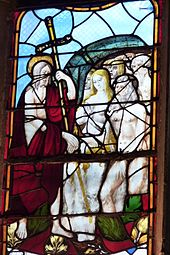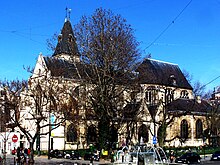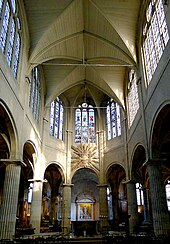St-Médard (Paris)
The Catholic parish church of Saint-Médard was from the 15./16. Erected in the late Gothic style in the 17th century. It is located at 141 rue Mouffetard in the 5th arrondissement on the left bank of the Seine in Paris . The nearest metro station is the Censier-Daubenton station on line 7 .
history
Saint-Médard was first written in 1163 in a bull of Pope Alexander III. mentioned. In 1978 Merovingian sarcophagi were discovered during excavations in the vicinity of the church , suggesting a much older predecessor church. The church, consecrated to St. Medardus († 545), Bishop of Noyon and later Bishop of Tournai , was located on the Roman road from Lutetia to Lyon , near the point where it crossed the Bièvre .
The current building was erected from the middle of the 15th or the beginning of the 16th century on the foundations of the Romanesque previous building. The construction work, which was interrupted several times, was only completed in the 18th century. During the wars of religion in 1561 the so-called "tumult of Saint-Médard" broke out, during which the church was stormed and devastated by Protestants .
In 1655, Saint-Médard was incorporated into the Archdiocese of Paris as the parish church of the Faubourg Saint-Marcel . Before that, it was subordinate to the Sainte-Geneviève Abbey , whose monks looked after the parish until the French Revolution of 1789.
In 1773 the unadorned entrance portal was added to the west facade. In 1784, Louis-François Petit-Radel redesigned the choir in the classical style, had fluted columns with Doric capitals built in and the large Lady Chapel added . He also added the sacristy on the south side.
Under the National Convention , the church was closed. At times it served the theophilanthropy as the Temple du Travail (Temple of Labor) until it was used again as a Catholic Church.
Since the law separating church and state of 1905, the Saint-Médard church has been owned by the city of Paris. In 1906 it was added to the list of French cultural monuments as Monument historique .
Convulsionaires of Saint-Médard
The Saint-Médard church, located near the Abbey of Port-Royal , was visited by numerous followers of Jansenism . The deacon François de Pâris (1690–1727), who had supported the Jansenists in the dispute over the papal bull Unigenitus Dei Filius of 1713 , was buried in the small cemetery, which was originally attached to the apse of the church . At his grave, where miraculous healings are said to have taken place, the so-called convulsionaries of Saint-Médard gathered . In order to curb the hustle and bustle, was in 1732 at the behest of King Louis XV. the cemetery closed. A stranger then put a sign at the entrance with the inscription: "In the name of the king, God is forbidden to work miracles in this place."
architecture
The bell tower rests on a foundation from the Romanesque period. It was increased in the 16th century. The interior is divided into three naves and five bays . The first three yokes - like the large facade window in the flamboyant style - come from the first construction phase. The fourth and fifth yokes and the choir date back to the second half of the 16th century, the ambulatory and the vault of the choir to the early 17th century.
The central nave and side aisles are covered with a ribbed vault. The keystones of the main nave are carved. Chapels open in the two side aisles . The choir adjoins the nave without an inserted transept . The round arched arcades , which were redesigned in the 18th century, close the choir, which towers above the central nave in height and width, from the ambulatory.
Furnishing
The pulpit of the church dates from 1718.
In the church are the paintings:
- The Wandering of St. Joseph and the Baby Jesus by Francisco de Zurbarán (1598–1664) in a chapel in the ambulatory
- Christ in the tomb according to Philippe de Champaigne (1602–1674) in a chapel in the ambulatory
- Jesus drives the traders out of the temple of Charles-Joseph Natoire (1700–1777) in the left aisle

Leaded glass window
Only fragments are left of the leaded glass windows from the 16th and 17th centuries. The central window of the apse with the depiction of Christ crucified , on the right of which stands Mary and on the left of which the Apostle John stands, is composed of pieces of different origins. The panes depicting the descent into hell of Christ , Saint Roch and Saint Anthony and a Majestas Domini in the chapels of the south aisle are Renaissance fragments . The window in a chapel in the north aisle with the depiction of the Archangel Michael defeating the dragon dates from the 19th century.
The large choir windows were commissioned by various artists (Jean-Hébert Stevens, Paul Bony, Maurice Tastemain and Pierre Cellier) in 1941.
organ
The organ was made by François-Henri Clicquot between 1765 and 1767 and largely renewed in 1880 by the brothers Edouard and Eugène Stolz. In 1933 it was restored by Gutschenritter and between 1980 and 2000 by the Dargassies organ building company. The organ prospectus , a work by the master carpenter Germain Pilon (or Pillon), is one of the oldest in Paris. It dates from 1644 to 1646 and is carved from oak . It is decorated with harpies , angels and angel heads and crowned with the sculpture of the risen Christ. In 1980 the organ was declared a monument historique . The instrument has 32 registers on three manuals and a pedal . The playing and stop actions are mechanical.
|
|
|
|
||||||||||||||||||||||||||||||||||||||||||||||||||||||||||||||||||||||||||||||||||||||||||||||||||||||||||||||||
- Coupling : II / I, III / I, III / II, I / P, II / P
literature
- Georges Brunel, Marie-Laure Deschamps-Bourgeon, Yves Gagneux: Dictionnaire des Églises de Paris . Paris 2000 (1st edition 1995), ISBN 2-903-11877-9 , pp. 299-302.
- Jean Colson, Marie-Christine Lauroa (ed.): Dictionnaire des Monuments de Paris . Paris 2003 (1st edition 1992), ISBN 2-84334-001-2 , pp. 717-718.
- Aline Dumoulin, Alexandra Ardisson, Jérôme Maingard, Murielle Antonello: Paris. D'Église en Église . Éditions Massin, Paris 2008, ISBN 978-2-7072-0583-4 , pp. 120–123.
Web links
- Église Saint-Médard in the Base Mérimée of the French Ministry of Culture (French)
Individual evidence
- ↑ More information about the organ ( Memento from May 25, 2006 in the Internet Archive )
Coordinates: 48 ° 50 ′ 23.7 " N , 2 ° 21 ′ 1.7" E


